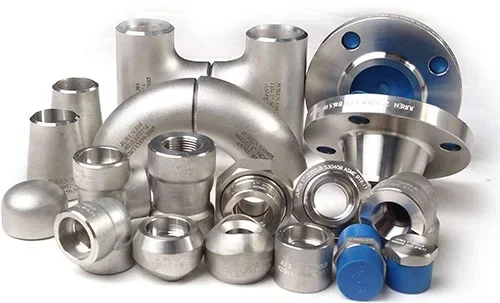Corrosion phenomenon and solution of stainless steel pipe fittings
Stainless steel pipe fittings are a kind of pipe connector widely used in industry, construction, aviation, ships, and other fields. Because of its excellent properties such as corrosion resistance, high-temperature resistance, and pressure resistance, it has been widely used in various fields. However, corrosion will also occur during use, which will not only affect its service life but also adversely affect production and life. Therefore, how to solve the corrosion problem has become an important topic.

Corrosion phenomenon of stainless steel pipe fittings
1. Pitting corrosion
Pitting corrosion is one of the most common forms of corrosion in stainless steel fittings. It is localized corrosion caused by local defects or contamination on the surface of the pipe fittings, resulting in a decrease in the local potential and the formation of tiny anode and cathode areas. Pitting corrosion is characterized by fast corrosion, but shallow corrosion depth.
2. Intergranular corrosion
Intergranular corrosion is a serious corrosion form of stainless steel pipe fittings. It is due to the high temperature or welding process of the pipe fittings, which makes the grains of the pipe fittings grow, and the chromium element at the grain boundary is exhausted, forming a low chromium area, which leads to intergranular corrosion. The characteristic of intergranular corrosion is that the corrosion rate is slow, but the corrosion depth is deep, which will cause the pipe to break in severe cases.
3. Stress corrosion
Stress corrosion is the corrosion caused by the interaction between pipe fittings and chemical substances in the medium under the action of stress. The characteristic of stress corrosion is that the corrosion speed is fast, but the corrosion depth is relatively shallow, which will cause the pipe fittings to break in severe cases.
Corrosion causes stainless steel pipe fittings
1. Medium corrosion
Medium corrosion is the corrosion caused by the corrosive substances contained in the medium in which the pipe fittings are located. For example, chemical substances such as acids, alkalis, and salts are all corrosive to a certain extent. If the pipe fittings are exposed to these media for a long time, they are prone to corrosion.
2. Oxidation corrosion
Oxidation corrosion is due to the destruction of the oxide layer on the surface of the pipe fittings, resulting in corrosion of the pipe fittings. For example, if the oxide layer on the surface of the pipe fittings is damaged by mechanical scratches, chemical corrosion, and other factors, oxidation corrosion is prone to occur.
3. Electrochemical corrosion
Electrochemical corrosion is local corrosion caused by the reduction of local potential on the surface of the pipe, forming tiny anode and cathode regions. For example, local defects or contamination on the surface of the pipe can easily form tiny anodic and cathodic areas, causing electrochemical corrosion.
Corrosion solution for stainless steel pipe fittings
In order to solve the corrosion problem of stainless steel pipe fittings, we can take the following measures:
1. Choose the right material
There are many kinds of materials for stainless steel pipe fittings, and different materials have different corrosion resistance. Therefore, when selecting stainless steel pipe fittings, the appropriate material should be selected according to the specific use environment and the corrosive properties of the medium.
2. Surface treatment
The surface treatment of stainless steel pipe fittings is one of the important means to prevent corrosion. Commonly used surface treatment methods include mechanical polishing, chemical treatment, electrochemical treatment, etc. These methods can effectively remove pollutants and oxides on the surface of pipe fittings and form a uniform oxide layer, thereby improving the corrosion resistance of pipe fittings.
3. Anti-corrosion coating
Anti-corrosion coating is a commonly used anti-corrosion method. Coating a layer of anti-corrosion coating on the surface of stainless steel pipe fittings can effectively prevent the pipe fittings from being corroded. Commonly used anti-corrosion coatings include epoxy coatings, polyurethane coatings, acrylic coatings, etc.
4. Control the corrosiveness of the medium
The corrosiveness of the medium is one of the main reasons for the corrosion of stainless steel pipe fittings. Therefore, when using, the corrosiveness of the medium should be controlled as much as possible. For example, when using stainless steel pipe fittings in a medium with many chemical substances such as acid, alkali, and salt, measures such as controlling the concentration of the medium and reducing the temperature of the medium can be taken to reduce corrosion of the pipe fittings.
In short, the corrosion of stainless steel pipe fittings is a complex problem that requires comprehensive treatment from multiple aspects. Only by taking scientific and reasonable measures can we effectively improve the corrosion resistance of pipe fittings, prolong their service life, and bring more convenience and safety to production and life.
The Different Types of Steel Pipe Fittings
Stainless steel pipe fittings appear rust spot how to deal with?
Causes of corrosion of stainless steel pipe fittings






